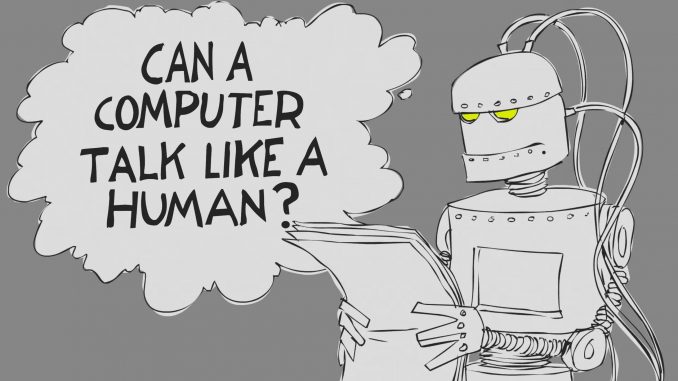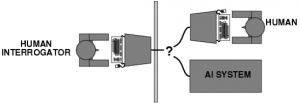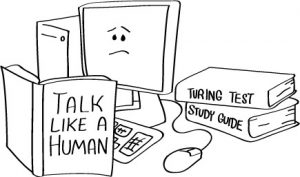
What is the Turing test?
The Turing test has been passed by a robot named Eugene. It may be time to pledge fealty to the machines
What is the Turing test, and what does it mean to our future.
Programmers all over the world may be preparing to usher in a new generation of highly advanced machines. This is after the University of Reading announced on Sunday that a computer had passed the Turing test for the first time since its inception in the 50s. What is the Turing test, and could it mean trouble for us?
The Turing Test was first developed by Alan Turing in 1950. Turing was a computer pioneer

of the 50s and he designed the test as a primary way to gauge a computer’s ability to demonstrate behavior that can be termed as intelligent or one that is similar to that of humans. Simply put, the test was designed to determine whether a machine was intelligent.
Turing designed this test to be performed as a series of imitations, or as an “imitation game”. The test involves a human judge seated on one side of a computer screen against the subjects. The judge’s sole function is to chat with an unknown entity on the other side and form a conclusion. As a form of control to the test, most of the entities on the other side are humans with the exception of the chatbot in question. The chatbot is introduced into the conversation to try to trick the judge into believing that it is a human responder. For the first time since the test was designed, a computer succeeded in tricking the human judge.
Or Is It Simply One Of Many Turing Tests?

Perhaps with a better understanding of the test, it may be more accurate to say that the Russian-made chatbot known as Eugene only passed a Turing test. The 1950 paper by Alan Turing presented the general idea of the test. The paper also presented specific suggestions that Turing believed would probably be passed within the following 50 years. According to the paper, each human judge was to be allowed only five minutes to interact with each machine in the test. Each machine was to be said to have passed only if more than 30% of the human judges believe that the machine was actually a human.
These rules as prescribed in Turing’s paper were the exact ones followed in the University of Reading test. It is still quite impressive though that the chatbot was able to make 33% percent of the judges believe that it was human. However, despite this achievement machines still have a long way to go before they can pass tests that are more modern, such as the generally accepted gold standard in modern Turing tests. This one uses rules that were recommended in 1990 by inventor Hugh Loebher. These relatively modern rules require the computer to interact for  25 minutes with four human judges separately. Here the computer is only said to have passed when it makes at least two out of the four judges believe that it is human. A bronze medal is usually awarded every year to the computer that wins over the most judges.
25 minutes with four human judges separately. Here the computer is only said to have passed when it makes at least two out of the four judges believe that it is human. A bronze medal is usually awarded every year to the computer that wins over the most judges.
So far, the toughest known Turing test is that which was designed as part of a $20,000 wager between Lotus founder, Mitch Kapor and futurologist Ray Kurzweil. Kapor bet that no machine would fairly pass the test before the year 2029. In this test, the rules require the challenger and three human participants to interact for two hours with each one of the three judges in the test. The robot must not only make two out of the three judges believe that it is human, but it must also be ranked as more human than at least two of the three human foils.
How do the robots win?
How the Participating Robots Are Supposed To WinCompetitions based on the Turing test have been held now for more than two decades. The designers of the robots have used a number of strategies over time to achieve their objective. Earlier on, their major challenges were simply getting the robots to understand the questions the judges asked. Nowadays however, the main challenge seems to get the machines to respond to the questions in ways that would be considered human.
Recently, winners of these competitions have found ways to convince the judges of their humanity by taking unconventional approaches to the test. Some of the machines have been known to change the subject of the conversation, simulate human moods, simulate typos, and even resort to asking questions of their own. The biggest force behind Eugene is probably that “he” was designed with the persona of an above average 13-year old boy. According to Vladimir Veselov, Eugene’s creator, the 13-year old persona made it possible for him to claim he knew everything while at the same time making it understandable whenever he didn’t know something. The young persona also makes its other diversionary actions such as spelling “mistakes” look more believable than they would if they came from an older persona.
Are We About To Welcome The Rule Of A New Race Of Robot Overlords?
The evidence does not suggest that that is about to happen, since the robot only passed the test because it was built to mimic the persona of a boy. That is not something that will exactly strike terror in the hearts of the average civilians. However, by making the machines merely to assume the role of chatbots may be a limited application of the kind of intelligence that sci-fi writers had imagined for them over the decades.
 Making the machines pretend to be humans will ultimately keep them from achieving their true potential. If the machines are also designed to act as humans, that may offer a number of possibilities and challenges in the future. Some of these challenges could include the rise of scambots that carry out phishing attacks and even customer support bots that are not obligated to inform the user that they are not humans.
Making the machines pretend to be humans will ultimately keep them from achieving their true potential. If the machines are also designed to act as humans, that may offer a number of possibilities and challenges in the future. Some of these challenges could include the rise of scambots that carry out phishing attacks and even customer support bots that are not obligated to inform the user that they are not humans.
But really, these machines say more about us than them. “You don’t write a program, you write a novel,” explain Eugene’s creators. “You think up a life for your character from scratch – starting with childhood – endowing him with opinions, thoughts, fears, quirks.” When the best way to pretend to be human is to imitate our foibles and weaknesses as much as our strengths, the victors of Turing tests will continue to be the least scary output of artificial intelligence research.